It is good to see that Christchurch has kicked off the post-quake blues and is fighting back. The shops have reopened, the schools will be back on Monday, the water is fit to drink once more, and even the CheeseMongers shop looks like it might be saved. Once they’ve got their city scrubbed up and the trains working again, perhaps its time to take a scenic trip down there and spend some tourist dollars to help their economy.
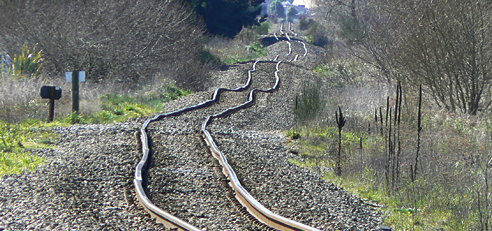
Meanwhile, a group of young architectural graduates have bandied together to set up a Design Competition called Ideas for Christchurch – competition closes Sept 25th, so you’d better get drawing.
“Choose your strategy, construct an argument, share a notion, indulge in joyful play, fight against or reach towards. Scale is open: form a strategic vision for the entire city; reconsider a hard hit suburb; preserve a local dairy. Salvage heritage and character, design temporary infills, sustainable developments, urban parks/reserves, inner-city living, a new typology of housing, a city of skyscrapers, a city of pickles… whatever you find interesting. We want ideas, ideas to stimulate interest and establish discussion to achieve the best for Christchurch.
Design, plan, write, draw, paint, model, dream… just share what you value and deliver it in an A3 digital format to ideasforchristchurch@gmail.com. Submit as often as you want, as a group or as an individual; identify yourself or remain anonymous.”

Ideas for Christchurch – Click Here
Meanwhile in Wellington, what to do about our very own looming disaster? We’ve always known it would happen sometime, now it just seems like we’re tempting fate to leave it on the back burner. Even Mayor Kerry has commented to much the same degree:
“Mayor Prendergast says she would ask staff to canvas a number of issues including whether the Council should:
* revisit the review of the quake-prone buildings policy with a view to tightening the deadlines again
* seek relaxation, where appropriate, of heritage rules to allow more latitude and flexibility in strengthening work. This could include the replacement of heavy masonry features like parapets or chimneys with replicas built from light materials like glass-fibre, timber or carbon-fibre.
* consider changes to District Plan rules to allow the demolition of some older buildings with less heritage value
* look at rule changes to force some building owners, if they can’t afford to strengthen, to remove heavy and dangerous features like parapets and chimneys from the roofs and facades of some buildings
* increase grant funding to help more building owners complete strengthening work.
The Council’s ongoing quake-prone programme has identified about 3800 mainly older commercial and multi-unit apartment buildings around the city as potentially quake-prone under the more stringent definitions in the revised Building Act 2004. Council engineers and consultants are about halfway through the process of either removing buildings from the quake-prone list or informing the owners that strengthening work is necessary.
“They have extrapolated that around 600 buildings around the city may need strengthening,” says Mayor Prendergast. “This is a difficult situation and a real challenge. My preference is that these buildings are not demolished to the extent that the city loses a lot of its soul. At the same time, I don’t want to see lives put at risk.”
One of our contributors, Sav, has suggested that funding could come from the EarthQuake Commission – seeing as they have a fund of some $16 billion apparently, perhaps they could help fund a bit more pro-active strengthening of buildings in the mean time? Someone else I spoke to suggested that what we really needed was a really big rubber stamp to highlight the buildings that were at risk. Would people use them so willingly if they thought they might fall down? Perhaps all buildings that have already been seismically strengthened should get a big tick like the Heart Foundation do with Healthy Eating foods:

Perhaps those that don’t, should get a warning sign plastered onto their heritage facade:
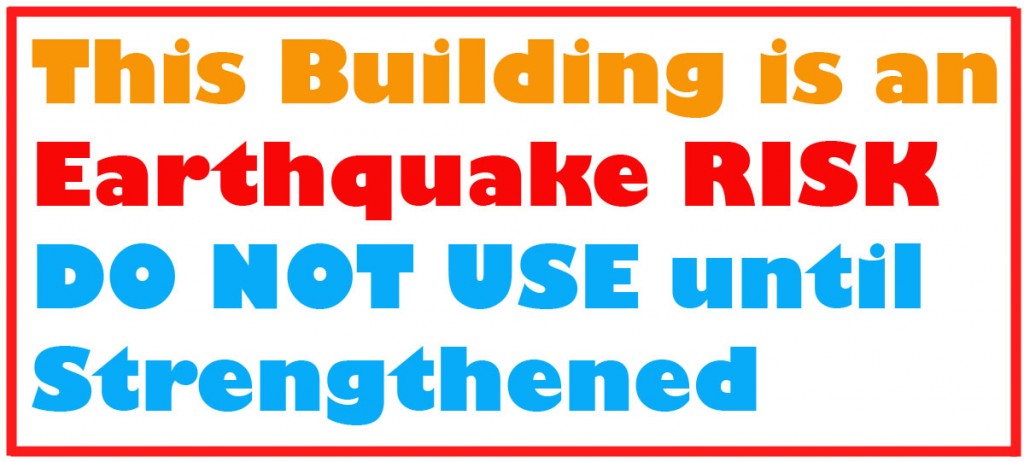
These could be applied to buildings at risk of losing their religion heritage, such as these charming mock-ups:

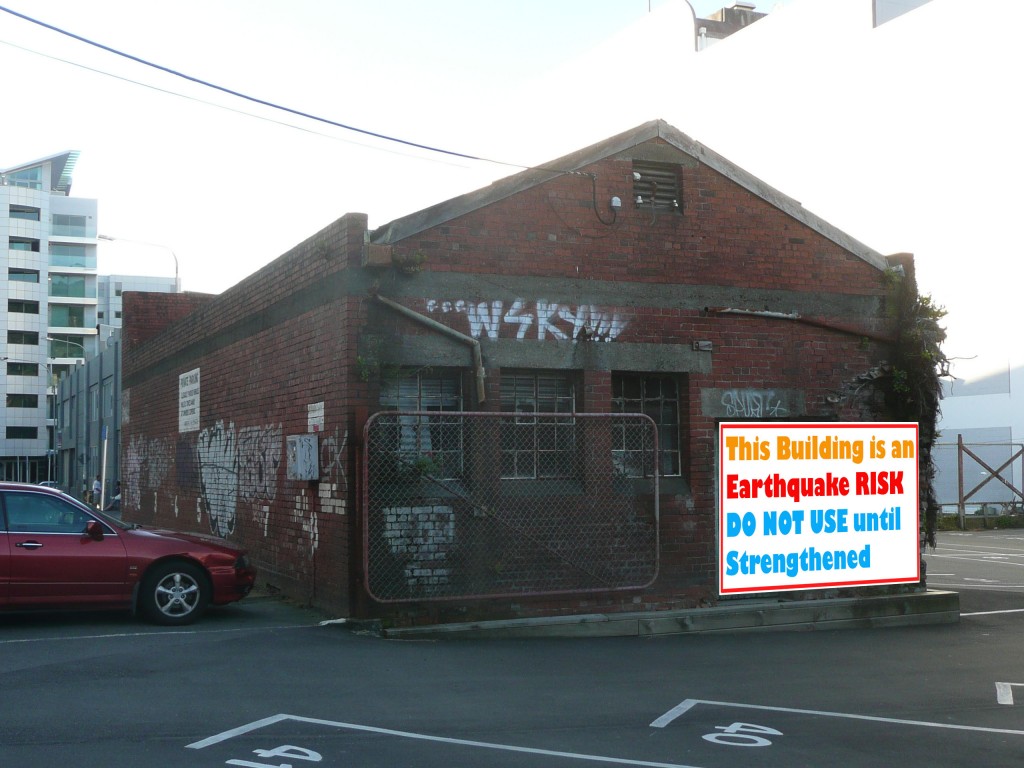
The sharp-eyed amongst you may have noticed that these signs are slightly larger than the previous notices that have been placed by the Council. Please note: this is not to say that these particular buildings shown here are unstrengthened, or in danger of falling – only the Council and their consulting engineers know that to any truthful degree. These ones here may be just fine. But they’re, let’s say, a representation of what might be an “at risk” building in Wellington (with thanks to Alan Wylde for the original photos).
Whatever is left of the Historic Places Trust (either about to have a rebirth, or a funeral, depending on your point of view) will have a pretty good idea too.
There are of course other signs that could be installed on buildings here: for those buildings that seem to be a little uncared for, we could have something like this:
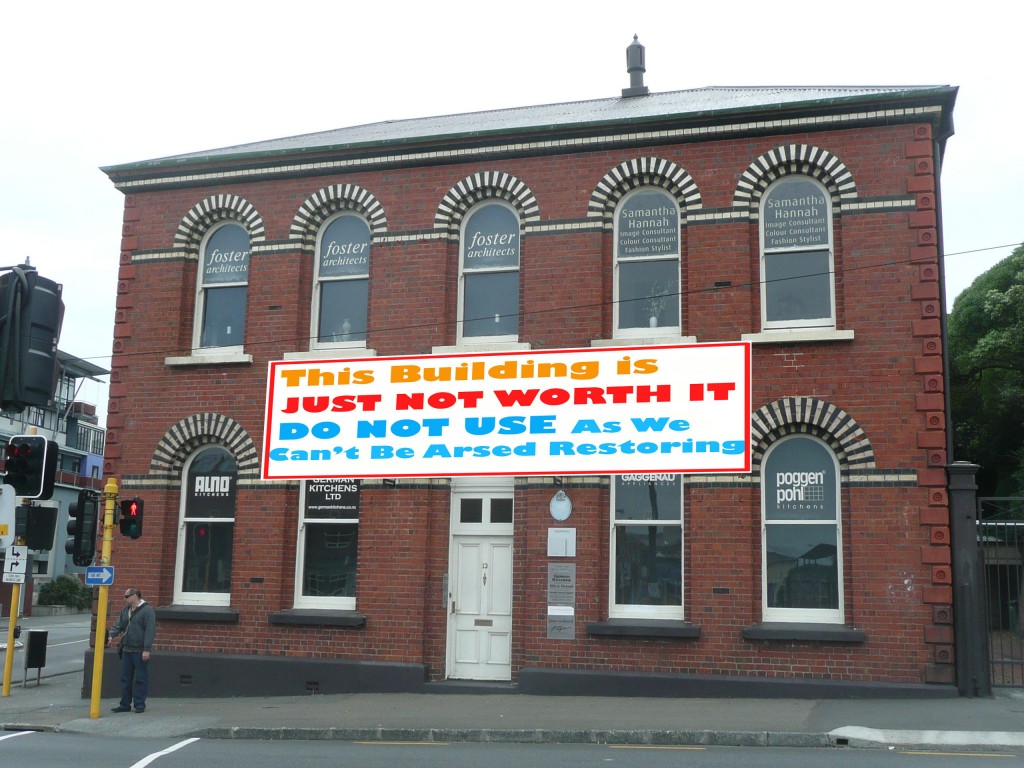
But then I think that is all a bit mean and one sided. No doubt people would complain about loss of income if their building was declared to be a risk. The arbitrary nature of the damage in Christchurch has shown that some buildings have been damaged more than others, even when constructed in a similar manner. The only definite statement that seems to have rung true is that if buildings are constructed to the modern building standards, then they seem to have been through the quake unscathed. Or, if you’re a Peter Beaven fan, build in a full Gothic style, as that did pretty well too.
But we’re short on Goths and Gothics up here right now, so we might just have to stick with the modern, as well as the heritage restorations. However, potential disuse due to potential future collapse shouldn’t be the only reason we should avoid some buildings. Some buildings are just too ugly, too badly designed, too plain hideous to look at – and they shouldn’t go unpunished either. Here’s a selection of possible buildings with possible slogans:
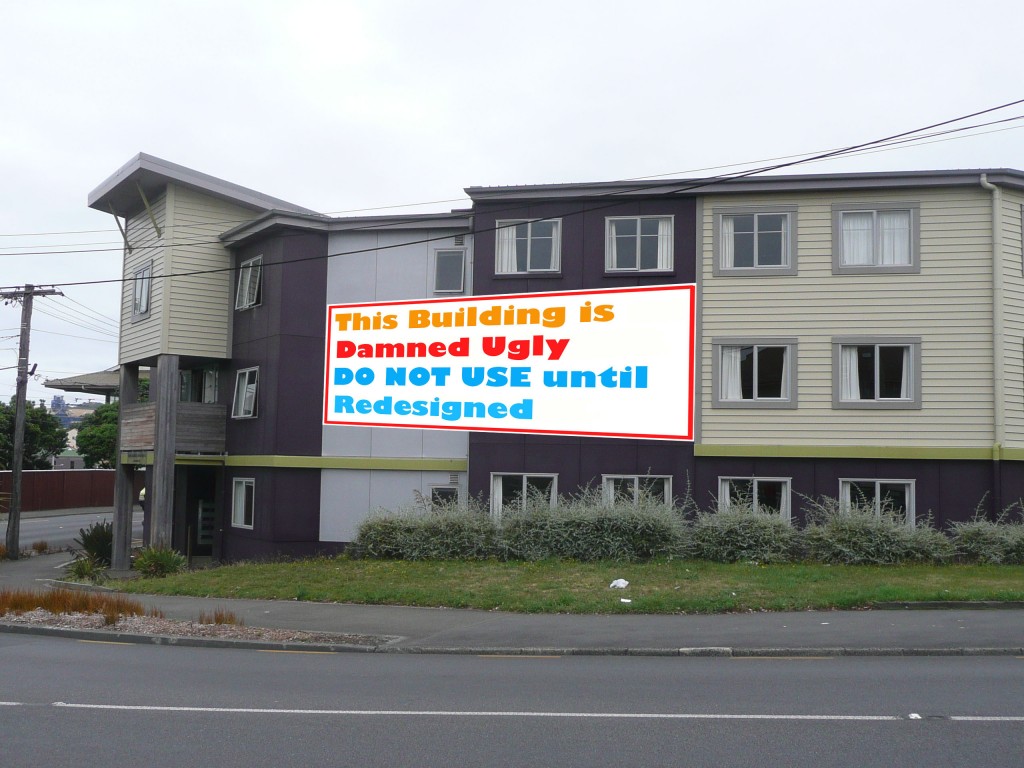
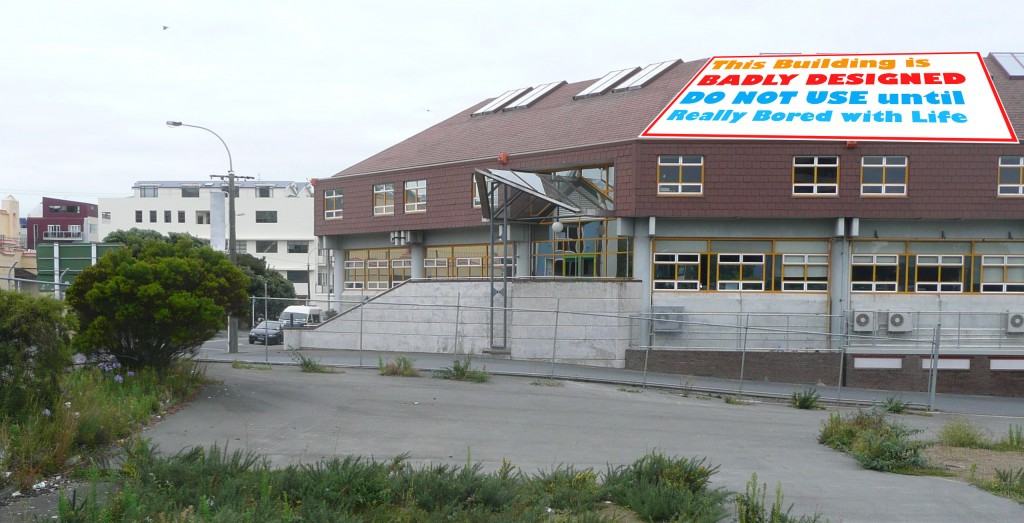
It’s just a selection of possibilities, and maybe you will have a better idea – if so, send us your comments, or if you have a picture, send it in to our contact email address. In the mean time we’ve prepared a simple cut-out-and-keep version just for you:
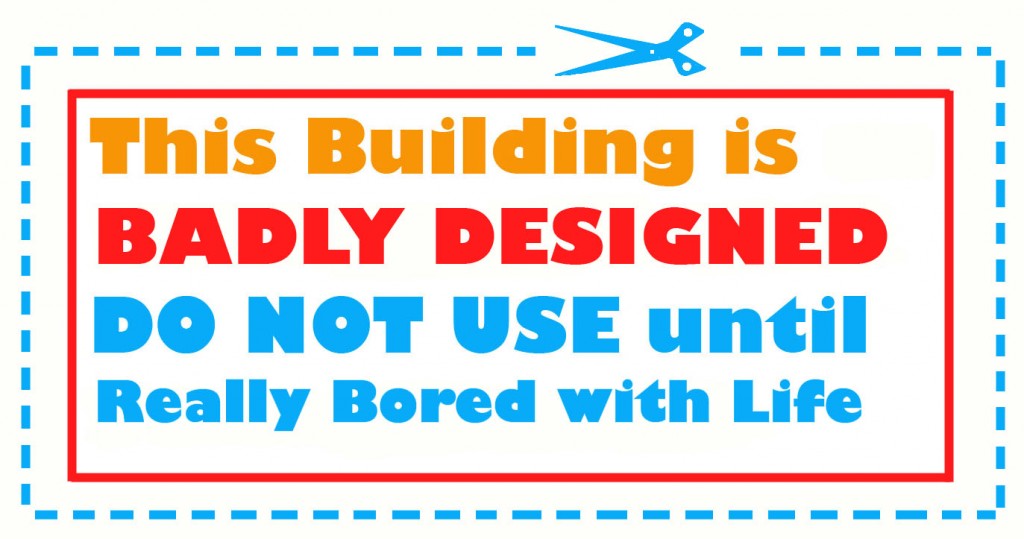

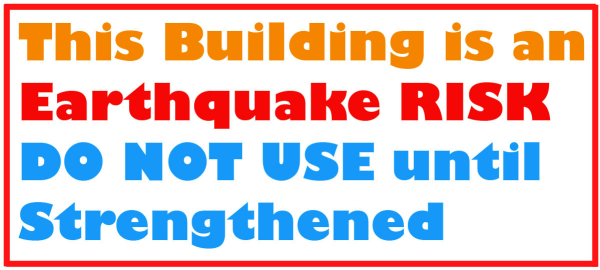
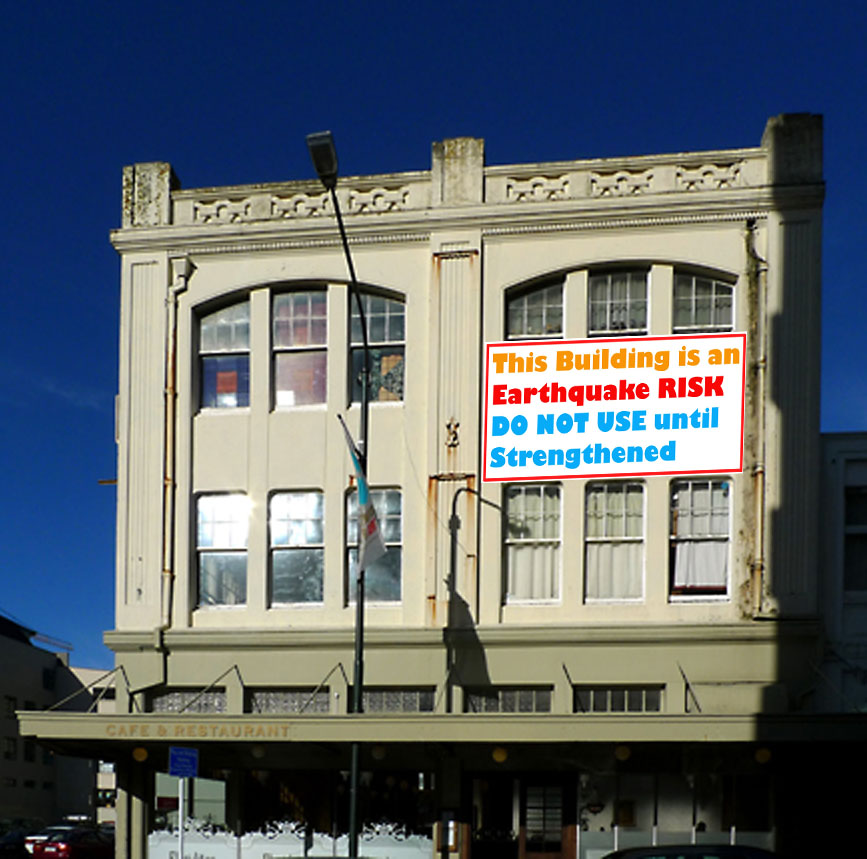



A superb commentary on some very difficult questions. Wellington has got to think hard on the question of funding heritage restoration as we have a legacy of following strengthening legislation with the wrecking ball. In my heart of hearts I cannot believe anyone would consider knocking over any more of the few reminders of our past… if we bring forward ‘upgrade or demolish’ legislation we had better be prepared to do a good job of saving buildings. It is fairly plain, most owners of heritage buildings, do not have the proper funding to do the necessary work without some assistance. Any financial investment is not matched by comparable return for the owner yet the return for keeping lies strongest with the community and its soul. It is well past time that a lasting fund is set up in New Zealand that makes the very real difference needed to both, save buildings now and prevent them from being the future hazard of a local quake.
>No doubt people would complain about loss of income if their building was declared to be a risk.
This isn’t just an issue about commercial landlords or a handful of “heritage” buildings. It’s about the majority of inner city apartment buildings. Any tightening of earthquake regulations risks making inner city apartments unsaleable and bankrupting thousands of people who own apartments. That is going to ruin a lot of lives and set Wellington back to the 1970s when suburbs ruled.
Those of us who live in the CBD know about earthquake risks. We accept them.
Davidp – unsaleable ? That’s unlikely, but it is an interesting point. All the apartments in the inner city have been created in the last 10-15 years, the more recent ones purpose designed, and the older ones retrofitted from older apartment buildings. In either case, the apartment buildings would have been subject to modern building code standards.
New buildings Must meet the current Code – whereas older buildings, with a change of use, must be made to be ‘As near as is Reasonably Practicable’ to the current code.
I think you’ll find the buildings that are going to be targeted for Upgrading are the old ones that have not yet gone through a change of use. Commercial / Retail upgrades : your time has come.
I’m not an expert, but my understanding is that buildings constructed to the 1965 code currently comply with about 35% of the current code and this is permitted. WCC conducted a review of compliance a couple of years ago, have spent the best part of the past year processing the appeals, and still have a huge backlog of appeals to work their way through. Including my own building’s, where they thought we fell just below the cutoff and our engineer thought we fell just above… we submitted our appeal over a year ago and still haven’t heard back from WCC.
If WCC raise the code standard or raise the percentage of the standard that old buildings have to meet, then hundreds (or possibly thousands) of existing buildings are going to need strengthening. Until that strengthening is done, then no one is going to buy an apartment in one which is while I say they’ll be unsaleable. The required strengthening will likely bankrupt some owners and cause significant hardship to all but the richest.
The last time WCC revised earthquake standards we lost most of Wellington’s old buildings. But the owners at the time were professional landlords and large companies who could mostly afford it. This time we’re likely to lose the rest of Wellington’s old buildings and it’ll wipe out inner city apartment owners. I’m guessing that will cause a mass migration out of the CBD to the suburbs as it’d take a brave person to invest in CBD residential property after seeing what happened to their predecessors.
Yes, perhaps unsaleable isn’t an overstatement… It is difficult to get a mortgage without insurance, and impossible to get insurance on a building deemed to be at risk from certain calamities (especially fire-risk from older wiring for example).
After Chch, NZ insurance companies may just start to revise their criteria…
Although, in a curious case of what goes unsaid being more important than what is said – if you don’t have a letter from the Council, you’re probably ok. Its only the ones who have had a definite reply saying “Strengthen” that legally need to do so.
If the Council have not replied, then they’re not going to do so – if they were to give you the ok, and then your building fell down, they might be in the legal firing line. So, for them, better they stay schtumm.
Insurances go up and down all the time. Insurance companies still make massive profits. Our insurance went up after Sept 11, 2001, due to the dangers of Al Qaida. It has made its way back down again over the last few years, as the realistic threat of mad fundamentalists has receded in NZ.
Now we just have a mad fundament instead.
Things are really hotting up in NZ after the Chch earthquake. With curious coincidence there is a Heritage Awards panel meeting in Chch this week, and they’re able to see the damage first hand.
http://www.stuff.co.nz/the-press/news/4121562/Don-t-rush-into-demolition-heritage-experts
“Rushed demolition can do more damage to heritage buildings than the original earthquake, a panel of experts visiting Christchurch has warned. The warning comes as Christchurch Mayor Bob Parker threatened action against those who demolished buildings without consent.
“There are some significant penalties for that and so we need to remind people that if it is your belief that a building you own needs to be demolished then you need to see the council. Let’s not rush to pull buildings down. We want people to think about this very carefully. Demolition is a no-no if you do not have permission and it is not the first choice of this council,” said Parker.
…..Panel member Dame Anne Salmond said the visit had “uncanny timing”.
“Everybody just felt that with the aftershocks continuing all of us wanted to be here with the people of Christchurch and show some support. We are seeing an extraordinary combination of heart-breaking images and stories of the damage to the heritage of this wonderful city,” she said. Salmond said the first 10 days after a quake were important for the protection of heritage buildings.
“It is very important not to leap in with the bulldozers as the first reaction,” she said. “In the first 10 days after an earthquake more damage can be done to the heritage fabric and it can exceed the damage done by the earthquake if there is not the time taken to think matters through and get expert advice. We want to avoid decisions that the people of Christchurch will regret for generations.”
The NZIA has made a big bold move into the Christchurch rebuilding debate, with a group of architects including Richard Dalman (the local NZIA branch chair) and Ian Athfield (a Wellingtonian, but with a big Christchurch office).
http://www.stuff.co.nz/the-press/news/christchurch-earthquake/4129202/Row-grows-over-rebuilding
“A dispute over how to rebuild earthquake-ravaged Christchurch is escalating, with criticism over the appointment of Ian Athfield as “architectural ambassador” for the reconstruction. Christchurch Mayor Bob Parker announced yesterday that Wellington-based Athfield would head a team of architects and urban designers to prepare concept ideas and designs for the city rebuild. His company, Athfield Architects, designed Christchurch’s new $113 million civic building for the Christchurch City Council, which suffered an estimated $2.5 million damage in the September 4 earthquake.
Opened only last month, it was shut for a week after the earthquake and scaffolding was still in place around staircases when The Press visited yesterday. Athfield’s appointment followed an offer on Monday from the New Zealand Institute of Architects which Parker called “manna from heaven”. He said the team, whose other members had not been finalised but would include senior Christchurch architects, had donated their time and skills.
The group would spend about two months coming up with concepts for filling many of the “gaps” around the city, which would go to the public for their input. Issues surrounding the future of the city’s damaged heritage buildings would not be part of the team’s brief. Athfield, who was announced as the city’s architectural ambassador, said he saw his role as “a position of collaboration” with other professionals. The group would be independent of the council, he said.
Parker’s mayoral rival, Wigram MP Jim Anderton, along with city councillors Chrissie Williams and Yani Johanson said Parker should stop making such appointments “without the support, backing or vote of the democratically elected council”.
“Whether or not this is the right team to lead the architectural revitalisation is immaterial,” Anderton said. “Bob is shutting out the people’s voice. Poor process and excluding the people is not the way to rebuild our city. Bob may have emergency powers but this in not an emergency decision.”
Institute of Architects Canterbury councillor Richard Dalman said Christchurch-born and bred Athfield was chosen to lead the group because of his skills and passion for urban design and his drive to see the city’s rebuilding through. The institute had come up with the idea because it wanted to help “bring the city back to life again”.
But it is this push to change all the legislation that has really got me concerned. It is a bit like the over-reaction that happened in the world after the Twin Towers – governments in US, UK, and even in NZ all voted in silly emergency security powers giving certain government departments freedom from scrutiny. Now they’re all on the loose and can’t be reined back in. The emergency powers passed last night even gives freedom from the Official Information Act – so not only can they debate things in secret, they can do it in perpetuity as well – quite extraordinary powers – passed in haste, regret in leisure:
http://www.stuff.co.nz/national/politics/4129102/Rebuilding-boosted-by-extra-powers
“Emergency legislation rushed through Parliament has given the Government extraordinary powers to rebuild Christchurch. The legislation allows the Government to override several laws without the threat of legal challenge after it ruled out the right of any court to review, quash or call into question decisions under the Canterbury Earthquake Response and Recovery Act.
“Faced with a massive damage bill and an uncertain future for many homeowners and business owners, the Government says it needs the powers to get the city back on its feet as soon as possible. Earthquake Recovery Minister Gerry Brownlee confirmed that included exempting the seven-person Canterbury Earthquake Recovery Commission from scrutiny under the Official Information Act as it makes decisions on the rebuilding of Christchurch. It also exempts commissioners from any liability.”
Settle Gretel, there’s a sunset clause on them there emergency powers.
This is a government that’s scared of upsetting farmers,LAQC property trust owners and the financial markets.They’re a pack of sooks.
It is the power they have given themselves before they ride off into the sunset that is the real worry. This is sledgehammer to crack a walnut territory, ill-thought out and ott (something we might have expected from Labour in its final term).
there is an interesting response here: http://dimpost.wordpress.com/2010/09/15/scenarios/
…which includes, in near the end of the piece:
“But the real danger is the damage that will be caused by simple bad judgement – changes to laws and regulations that will have terrible and expensive consequences of the ‘leaky building’ variety. That was also caused by a desire to ‘speed things up’, ‘get the bureaucrats out of the way’ and so on.”
I am a little bit cynical here about the need for funding to save heritage buildings.
First up, most of the “character” buildings in the inner city that need strengthening have been returning their owners rents and good returns since the 1965 Act….and they have had huge capital gains. They are businesses, subject to commercial laws and regulations, same as any other business. As such they can profit or go to the wall.
Second up I believe that the owners of those buildings left unstrengthened have been playing fast and loose with the lifes of the rest of us. One person killed by falling masonry etc is worth far more than all the “heritage” buildings strengthening costs. It sickens me that the owners of these now say they cannot afford to strengthen and want a hand out. Where did the afore mentioned cash go?
My take is that if they cannot afford to strengthen the owners should be in the same boat as a trucking company whose trucks fail to pass WoF. Its off the road, no income. If they go bust the vacant building should be subject to the same commercial rules, sold off at true value. This may be zero if unstrengthened. Too hard I hear you say? How many of you shed tears for previous bankrupts or companies that have gone to the wall?
Fred, I completely agree.
I can see it leading to more demolition but given what happened to Chch, I think that we need to bite the bullet here in Shakytown sooner rather than later
Well, yeah, but nah. While many of us would not shed a tear for the sake of an old trucking company if it is driven into the wall (so to speak), I suspect that more of us would care more for old buildings that may get torn down.
I really do like old buildings – although I also do like building new ones. If we recognise that almost no old building can ever be recreated (ok – weta can, but they are only polystyrene – oooh, and the Supreme Court can, but at a cost of umpteen zillions…), then the thing to be debating here in terms of heritage is in terms of Quality of the old stuff.
Really, if they’re old but unexciting, then we shouldn’t be crying over them. On the other hand, if they are fantastic old buildings with excellent redeeming features, then I’d do anything to save them.
So it all comes down to value judgments, but whose?
Chew on this one: http://www.legislation.govt.nz/regulation/public/2010/0333/latest/whole.html
Gerry’s 6th proclamation, this one having direct effect on national heritage…